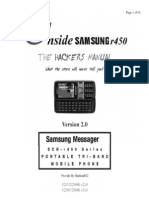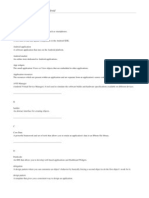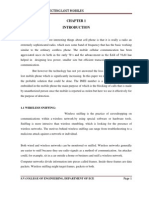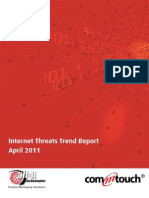Mobile Phone Cloning Report
Mobile Phone Cloning Report
Uploaded by
Rahul GuptaCopyright:
Available Formats
Mobile Phone Cloning Report
Mobile Phone Cloning Report
Uploaded by
Rahul GuptaOriginal Description:
Copyright
Available Formats
Share this document
Did you find this document useful?
Is this content inappropriate?
Copyright:
Available Formats
Mobile Phone Cloning Report
Mobile Phone Cloning Report
Uploaded by
Rahul GuptaCopyright:
Available Formats
MOBILE PHONE CLONING
INTRODUCTION
Mobile communication has been readily available for several years, and is major business today. It provides a valuable service to its users who are willing to pay a considerable premium over a fixed line phone, to be able to walk and talk freely. Because of its usefulness and the money involved in the business, it is subject to fraud. Unfortunately, the advance of security standards has not kept pace with the dissemination of mobile communication. Some of the features of mobile communication make it an alluring target for criminals. It is a relatively new invention, so not all people are quite familiar with its possibilities, in good or in bad. Its newness also means intense competition among mobile phone service providers as they are attracting customers. The major threat to mobile phone is from cloning.
What is Cloning : Cloning is the creation of an organism that is an exact genetic copy of another. This means that every single bit of DNA is the same between the two. Remember Dolly the lamb, cloned from a six-year-old ewe in 1997, by a group of researchers at the Roslin Institute in Scotland. While the debate on the ethics of cloning continues, human race, for the first time, are faced with a more tangible and harmful version of cloning and this time it is your cell phone that is the target. Millions of cell phones users, be it GSM or CDMA, run at risk of having their phones cloned. As a cell phone user if you have been receiving exorbitantly high bills for calls that were never placed, chances are that your cell phone could be cloned.
AISSMS COE, COMPUTER ENGINEERING 2013
Page 1
MOBILE PHONE CLONING
Mobile Phone Cloning: Cloning is the process of taking the programmed information that is stored in a legitimate mobile phone and illegally programming the identical information into another mobile phone. The result is that the cloned phone can make and receive calls and the charges for those calls are billed to the legitimate subscriber. The service provider network does not have a way to differentiate between the legitimate phone and the cloned phone. Phone cloning is the transfer of identity between one mobile telephone and another. Phone cloning is outlawed in the United Kingdom by the Wireless Telephone Protection Act of 1998. Usually this is done for the purpose of making fraud lent telephone calls. The bills for the calls go to the legitimate subscriber. The early 1990s were boom times for eavesdroppers. Any curious teenager with a 100 Tandy Scanner could listen in to nearly any analogue mobile phone call. As a result, Cabinet Ministers, company chiefs and celebrities routinely found their most intimate conversations published in the next day's tabloids. Cell phone cloning started with Motorola bag phones and reached its peak in the mid 90's with a commonly available modification for the Motorola brick phones, such as the Classic, the Ultra Classic, and the Model 8000. The Economic Crimes Policy Team was chartered to advance the Commissions work in several areas, including the development of options for implementing the directives contained in the Wireless Telephone Protection Act. Specifically, this act amended 18 U.S.C. $ 1029 (Fraud and related activity in connection with access devices) with regard to the cloning of cellular telephones. The purpose of mobile phone cloning is making fraudulent telephone calls. The bills for the calls go to the legitimate subscriber. The cloner is also able to make effectively anonymous calls, which attracts another group of interested users.
AISSMS COE, COMPUTER ENGINEERING 2013
Page 2
MOBILE PHONE CLONING
Fig: Cellular Phone Cloning Cell phone cloning is a technique wherein security data from one cell phone is transferred into another phone. The other cell phone becomes the exact replica of the original cell phone like a clone. As a result, while calls can be made from both phones, only the original is billed. Though communication channels are equipped with security algorithms, yet cloners get away with the help of loop holes in systems. So when one gets huge bills, the chances are that the phone is being cloned. Wireless Telephone Protection Act: Because of increasing financial losses to the telecommunications industry and the growing use of cloned phones in connection with other criminal activity, Congress passed the Wireless Telephone Protection Act (WTPA) in April 1998. The legislative history indicates that, in amending 18 U.S.C. 1029, Congress was attempting to address two primary concerns presented by law enforcement and the wireless telecommunications industry. First law enforcement officials testified at congressional hearings that they were having difficulty proving the intent to defraud element of the pre-amendment provision regarding some equipment used to clone phones.
AISSMS COE, COMPUTER ENGINEERING 2013
Page 3
MOBILE PHONE CLONING
Although there is no legitimate reason to possess the equipment unless an individual is employed in the telecommunications industry, the prosecution often could not prove that the equipment was possessed with the intent to defraud. Second law enforcement officials often discovered cloning equipment and cloned cellular telephones in the course of investigating other criminal activities, such as drug trafficking and other fraud. The use of cloned phones to facilitate other crimes increases the ability of offenders to escape detection because of the increased mobility and anonymity afforded by the phones. Gangs and foreign terrorist groups are also known to sell or rent cloned phones to finance their illegal activities. With these concerns in mind, Congress amended section 1029 in 1998. The significant changes to the statute include Elimination of the intent to defraud element with respect to persons who knowingly use, produce, traffic in, have custody or control of, or possess hardware (a "copycat box") or software which has been configured for altering or modifying a telecommunications instrument. Modification of the current definition of "scanning receiver" to ensure that the term is understood to include a device that can be used to intercept an electronic serial number, mobile identification number, or other identifier of any telecommunications service, equipment, or instrument. Correction of an error in the current penalty provision of 18 U.S.C. 1029 that provided two different statutory maximum penalties (ten and 15 years) for the same offense. With respect to cellular phone cloning, the Act makes clear that a person convicted of such an offense without a prior section 1029 conviction is subject to a statutory maximum of 15 years; a person convicted of such an offense after a prior section 1029 conviction is subject to a statutory maximum of 20 years. The cloning of a cellular telephone occurs when the account number of a victim telephone user is stolen and reprogrammed into another cellular telephone. Each cellular phone has a unique pair of identifying numbers: the electronic serial number ESN and the mobile identification number MIN. The
AISSMS COE, COMPUTER ENGINEERING 2013
Page 4
MOBILE PHONE CLONING
ESN/MIN pair can be cloned in a number of ways without the knowledge of the carrier or subscriber through the use of electronic scanning devices. After the ESN/MIN pair is captured, the cloner reprograms or alters the microchip of any wireless phone to create a clone of the wireless phone from which the ESN/MIN pair was stolen. The entire programming process takes ten-15 minutes per phone. After this process is completed, both phones (the legitimate and the clone) are billed to the original, legitimate account. The cellular telephone industry does not charge legitimate, victimized customers for fraudulent calls rather the companies absorb the losses themselves. In addition to losses due to fraudulent billing, the cellular companies incur losses due to the fees paid for connections and long-distance.
AISSMS COE, COMPUTER ENGINEERING 2013
Page 5
MOBILE PHONE CLONING
LITERATURE SURVEY
History: The early 1990s were boom times for eavesdroppers. Any curious teenager with a 100 Tandy Scanner could listen in to nearly any analogue mobile phone call. As a result, Cabinet Ministers, company chiefs and celebrities routinely found their most intimate conversations published in the next day's tabloids. Mobile phone cloning started with Motorola bag phones and reached its peak in the mid 90s with a commonly available modification for the Motorola brick phones , such as the Classic, the Ultra Classic, and the Model 8000. The Cellular Telecommunications Industry Association (CTIA) estimates that financial losses in due to cloning fraud are between $600 million and $900 million in the United States. Some subscribers of Reliance had to suffer because their phone was cloned. Mobile Cloning is in initial stages in India so preventive steps should be taken by the network provider and the Government. On April 13, 1998, the Smartcard Developer Association and the ISAAC security research group announced a flaw in the authentication codes found in digital GSM cell phones. This allows an attacker with physical access to a target phone to make an exact duplicate (a clone'') and to make fraudulent calls billed to the target user's account. Press coverage: The Los Angeles Times [local copy]; The New York Times; The Associated Press; The Wall Street Journal; USA Today; Wired News; Time daily; Time magazine; The Netly News; CNN; ABC News; Wireless Daily News [local copy]; The Daily Californian.
AISSMS COE, COMPUTER ENGINEERING 2013
Page 6
MOBILE PHONE CLONING
Fig: Semi Annual Fraud Dollar Losses in U.S. Three years later: Indications are that the GSM industry is taking steps to repair the security weaknesses in the GSM cryptographic algorithms. A patched version of COMP128 is now available (called COMP128-2), although it remains unpublished. The U.S. Secret Service and the wireless telecommunications industry are increasingly concerned about wireless fraud. First, the wireless telecommunication industry asserts that wireless fraud has grown exponentially since its introduction into the market. They estimate that wireless fraud costs the telecommunications industry over $650 million per year. Second, according to the Secret Service cloned phones are the communications medium of choice for criminals because it gives them mobile communications and anonymity. Cloned phones are difficult to detect and trace , and phone numbers can be changed in an instant. Law Enforcement reports an increase in the number of cloned phones confiscated during investigations of other offenses, such as drug distribution and credit card fraud. There are four major types of cellular fraud: counterfeit fraud, subscription fraud, network fraud, and call selling operations. Explanations of each are provided below. These cellular telecommunications violations are similar to other access device violations (e.g. credit cards) in that they involve unauthorized use
AISSMS COE, COMPUTER ENGINEERING 2013
Page 7
MOBILE PHONE CLONING
and/or access to individual accounts. The changes in 18 U.S.C. 1029 are aimed at counterfeit fraud, specifically, the cloning of cellular telephones. Counterfeit Fraud (cloning): Involves the use of illegally altered cellular phones Offenders gain access to legitimate account number combinations and reprogram them into other handsets to gain unauthorized access to those accounts. Subscription Fraud: Includes schemes related to fraudulently obtaining cellular telephone accounts. These may involve employees of the cellular carrier, forgery of application information, or theft of subscriber information. Network Fraud: This advanced type of fraud includes efforts to exploit weaknesses in phone switch equipment and billing systems. Manipulation of current systems can result in third party billing, use of nonexistent account numbers, or the use of multiple phones on single accounts.
Fig: Cloning Statistics Call Selling Operations: This type of fraud involves using stolen calling card numbers and/or cellular account numbers to sell less expensive cellular long distance (often international) service to others. Most importantly, the GSM industry appears to have at least partially learned the important lesson here: security through obscurity doesn't work. The next-
AISSMS COE, COMPUTER ENGINEERING 2013
Page 8
MOBILE PHONE CLONING
generation replacement for GSM, called 3GPP, will use algorithms developed based on principles from the research literature. Note that the other major players in this arena moved some time ago to open design processes. This includes the next-generation AES standard process being shepherded by the US government, as well as the US cellular industry. The US cellular industry is an interesting case study: initially they used closed design, but after several of their cryptographic algorithms were rapidly broken by cryptographers in the open research community, to their credit they quickly moved to an open design process. I am glad that the GSM/3GPP industry has recognized the benefits of this approach. We also understand that the GSM Association has agreed to develop a new, stronger voice encryption cipher called A5/3, apparently based on Kasumi (a block cipher which was developed based on principles from the research literature). It will apparently become mandatory to support A5/3 at some point in the future. I strongly support the GSM Association's efforts to repair the ailing series of voice privacy algorithms and provide robust voice privacy protection for the future. Further information on cryptographic algorithms in GSM and 3GPP may be found at several web pages:
A very nice guide to 3GPP cryptographic algorithms, from Janos A. Csirik. A very nice set of links to information on GSM security, from Charles Brookson. A survey on GSM security, from Lauri Pesonen.
AISSMS COE, COMPUTER ENGINEERING 2013
Page 9
MOBILE PHONE CLONING
Over-the-air cloning: In our original announcement, we noted that we could not rule out the possibility of over-the-air attacks, but we emphasized that we had not demonstrated such an attack. At that time, we did not provide any further analysis on the resources required to mount an over-the-air attack. There was, for obvious reasons, considerable interest in the possibility of over-the-air attacks, and we had reason to suspect they might be possible, but we wanted to be extremely conservative in reporting only what we knew for certain was exploitable. That viewpoint is probably now best regarded as outdated. Since then, extensive conversations with many knowledgeable GSM engineers has caused us to conclude that over-the-air attacks must be considered available to the sophisticated attacker in practice. We still have not attempted to build a laboratory demonstration but the GSM experts we've spoken with have confirmed that it should be possible and practical to do so. They have reported that a number of aspects of the GSM protocols combine to make it possible to mount the mathematical chosen-input attack on COMP128, if one can build a fake base station. Such a fake base station does not need to support the full GSM protocol, and it may be possible to build one with an investment of approximately $10k. Some technical expertise is probably required to pull off the over-the-air cloning attack, and the attack requires over-the-air access to the target handset for a relatively long period of time. Therefore, this may be considered a lower level of risk than that found in old US analog systems with no authentication at all. Nonetheless, please note that it would be a mistake to underestimate the technical sophistication or the financial resources of some of today's attackers.
AISSMS COE, COMPUTER ENGINEERING 2013
Page 10
MOBILE PHONE CLONING
METHODOLOGY
Cell phone cloning is copying the identity of one mobile telephone to another mobile telephone. Cell phones send radio frequency transmissions through the air on two distinct channels, one for voice communications and the other for control signals.
Fig: SIM card SIM which stands for Subscriber Identification Module. The SIM has survived and evolved. Earlier the mobiles had the entire SIM card to be inserted in them such SIMs are called IDG-1 SIMs. The other in which we small part of the card which has the chip is inserted in the mobile and is known as PLUG-IN SIMs. When a cellular phone makes a call, it normally transmits its Electronic Security Number (ESN), Mobile Identification Number (MIN), its Station Class Mark (SCM) and the number called in a short burst of data. This burst is the short buzz you hear after you press the SEND button and before the tower catches the data. These four things are the components the cellular provider uses to ensure that the phone is programmed to be billed and that it also has the identity of both the customer and the phone. MIN and ESN is collectively known as the Pair which is used for the cell phone identification. When the cell site receives the pair signal, it determines if the requester is a legitimate registered user by comparing the requestor's pair to a cellular subscriber list. Once the cellular telephone's pair has been recognized, the cell site emits a control signal to permit the subscriber to place calls at will. This process, known as Anonymous Registration, is carried out each time the telephone is turned on or picked up by a new cell site.
AISSMS COE, COMPUTER ENGINEERING 2013 Page 11
MOBILE PHONE CLONING
Each cellular phone has a unique pair of identifying numbers: the electronic serial number ESN and the mobile identification number MIN. The ESN is programmed into the wireless phones microchip by the manufacturer at the time of production. The MIN is a ten-digit phone number that is assigned by the wireless carrier to a customer when an account is opened .The MIN can be changed by the carrier, but the ESN, by law, cannot be altered .When a cellular phone is first turned on, it emits a radio signal that broadcasts these numbers to the nearest cellular tower. The phone will continue to emit these signals at regular intervals, remaining in contact with the nearest cellular tower. These emissions(called autonomous registration) allow computers at the cellular carrier to know how to route incoming calls to that phone, to verify that the account is valid so that outgoing call scan be made, and to provide the foundation for proper billing of calls. This autonomous registration occurs whenever the phone is on, regardless of whether a call is actually in progress.
Fig: International Mobile Equipment Identifier.
The IMEI is an abbreviation for International Mobile Equipment Identifier, this is a 10 digit universally unique number of our GSM handset. I use the term Universally Unique because there cannot be 2 mobile phones having the same
AISSMS COE, COMPUTER ENGINEERING 2013
Page 12
MOBILE PHONE CLONING
IMEI number. This is a very valuable number and used in tracking mobile phones.
Cloning still works under the AMPS/NAMPS system, but has fallen in popularity as older clone able phones are more difficult to find and newer phones have not been successfully reverse-engineered. Cloning has been successfully demonstrated under GSM, but the process is not easy and it currently remains in the realm of serious hobbyists and researchers.
Fig: Mobile Identification Number MIN - The MIN (Mobile Identification Number) is simply the phone number of
the cellular telephone.
ESN - The ESN (Electronic Serial Number) is the serial number of your cellular
telephone. The ESN is transmitted to the cell site and used in conjunction with the NAME to verify that you are a legitimate user of the cellular system. When placing a call, the phone transmits both the ESN and the MIN to the network. These were, however, sent in the clear, so anyone with a suitable scanner could receive them. The eavesdropped codes would then be programmed into another phone, effectively cloning the original subscription. Any calls made on this cloned phone would be charged on the original customer.
AISSMS COE, COMPUTER ENGINEERING 2013 Page 13
MOBILE PHONE CLONING
WHAT IS PATAGONIA?
Patagonia is software available in the market which is used to clone CDMA phone. Using this software a cloner can take over the control of a CDMA phone i.e. cloning of phone. There are other Software available in the market to clone GSM phone. This software are easily available in the market. A SIM can be cloned again and again and they can be used at different places. Messages and calls sent by cloned phones can be tracked. However, if the accused manages to also clone the IMEI number of the handset, for which software are available, there is no way he can be traced. Too many users treat their mobile phones as gadgets rather than as a business assets covered by corporate security policy. There is lucrative black market in stolen and cloned SIM cards. This is possible because SIMs are not network specific and though tamper proof, their security is flawed. In fact ,a SIM can be cloned many times and the resulting cards used in numerous phones, each feeding illegally off the same bill. But there are locking mechanisms on the cellular phones that require a PIN to access the phone. An 8 digit PIN requires approximately 50,000,000 guesses, but there may be ways for sophisticated attackers to bypass it. With the shift to GSM digital, which now covers almost the entire UK mobile sector, the phone companies assure us that the bad old days are over. Mobile phones, then say, are more secure and privacy friendly. This is not entirely true. The alleged security of GSM relies on the myth that encryption the mathematical scrambling of our conversations makes it impossible for anyone to intercept and understand our words and while this claim looks good on paper, it does not stand up scrutiny. Usually this is done for the purpose of making fraudulent telephone calls. The bills for the calls go to the legitimate subscriber. The cloner is also able to make effectively anonymous calls, which attracts another group of interested users
AISSMS COE, COMPUTER ENGINEERING 2013 Page 14
MOBILE PHONE CLONING
Fig: Cloning Device
Cell phones are complex electronic devices, sensitive to heat, cold and excess moisture. But a cell phone's sensitivity isn't limited to extreme weather conditions. Analog cell phones, as opposed to the newer digital phones, can be cloned. This means that someone can tap into your cell phone's personal identification number and makes calls on the same account. In other words, with a little technical know-how, someone can steal your phone number and charge the calls made to your account. You won't even know it's happened, until you get your phone bill. How does cloning happen if each phone has its own unique identifying features? Whenever you dial a number from your cell phone, the ESN (electronic serial number) and MIN (mobile identification number) of your phone are transmitted to the network identifying the cell phone dialed from and who to bill. Some people, who work in the way that computer hackers operate, can use a scanner to listen in to this transmission and capture the code. They can then use the information they gather to make calls that are then charged to the account of the phone number they have in effect broken into.
AISSMS COE, COMPUTER ENGINEERING 2013
Page 15
MOBILE PHONE CLONING
IMPLEMENTATION
GSM: Global System for Mobile Communications. A digital cellular phone technology based on TDMA GSM phones use a Subscriber Identity Module (SIM) card that contains user account information. Any GSM phone becomes immediately programmed after plugging in the SIM card, thus allowing GSM phones to be easily rented or borrowed .Operators who provide GSM service are Airtel , Hutch etc. Looking at the recent case, it is quite possible to clone both GSM and CDMA sets. The accused in the Delhi case used software called Patagonia to clone only CDMA phones (Reliance and Tata Indicom). However, there are software packages that can be used to clone even GSM phones (e.g. Airtel, BSNL, Hutch, Idea). In order to clone a GSM phone, knowledge of the International Mobile Equipment Identity (IMEI) or instrument number is sufficient .But the GSM-based operators maintain that the fraud is happening on CDMA, for now, and so their subscribers wouldn't need to worry. Operators in other countries have deployed various technologies to tackle this menace. They are: 1) There's the duplicate detection method where the network sees the same phone in several places at the same time. Reactions include shutting them all off, so that the real customer will contact the operator because he has lost the service he is paying for. 2) Velocity trap is another test to check the situation, whereby the mobile phone seems to be moving at impossible or most unlikely speeds. For example, if a call is first made in Delhi, and five minutes later, another call is made but this time in Chennai, there must be two phones with the same identity on the network. 3) Some operators also use Radio Frequency fingerprinting, originally a military technology. Even identical radio equipment has a distinguishing fingerprint,
AISSMS COE, COMPUTER ENGINEERING 2013
Page 16
MOBILE PHONE CLONING
so the network software stores and compares fingerprints for all the phones that it sees. This way, it will spot the clones with the same identity, but different fingerprints .Usage profiling is another way wherein profiles of customers' phone usage are kept, and when discrepancies are noticed, the customer is contacted. For example, if a customer normally makes only local network calls but is suddenly placing calls to foreign countries for hours of airtime, it indicates a possible clone. Any GSM phone becomes immediately programmed after plugging in the SIM card, thus allowing GSM phones to be easily rented or borrowed Operators who provide GSM service are Airtel ,Hutch etc. CDMA: Code Division Multiple Access. A method for transmitting simultaneous signals over a shared portion of the spectrum. There is no Subscriber Identity Module (SIM) card unlike in GSM .Operators who provides CDMA service in India are Reliance and Tata Indicom. The answer is yes. In spite of this, the security functions which prevent eavesdropping and unauthorized users are emphasized by the mobile phone companies. The existing mobile communication networks are not safer than the fixed Telephone networks. They only offer protection against the new forms of abuse computer. The cloning of a cell phone allows the holder of the cloned phone to appear to be calling from the original phone so that any call charges are applied to the owner of the original phone. Since 1998 the Federal Communication Commission has made "the use, possession, manufacture or sale of cloning hardware or software" illegal. Electronic Serial Number: Each phone has an electronic serial number unique to that specific handset. Use of ESNs allows cellular radio networks to identify phones. When a phone connects to a network, the network can route calls and data consistently and reliably to the right device. Mobile Identifier Number: A mobile identifier number is a phone number. It works across networks and international calling areas to specifically route calls and data to a particular phone. Since MINs can be transferred from one network to
AISSMS COE, COMPUTER ENGINEERING 2013 Page 17
MOBILE PHONE CLONING
another, the MIN has to be identified with the ESN to create the network connection to the specific phone number.
SECURITY FUNCTIONS OF THE GSM AND CDMA As background to a better understanding of the attacks on the GSM and CDMA network. The following gives a brief introduction to the Security functions available in GSM. The following functions exist: Access control by means of a personal smart card (called subscriber Identity module, SIM) and PIN (personal identification number). Authentication of the users towards the network carrier and generation of A session key in order to prevent abuse. Encryption of communication on the radio interface, i.e. between mobile Station and base station. Concealing the users identity on the radio interface, i.e. a temporary valid Identity code (TMSI) is used for the identification of a mobile user instead Of the IMSI. WHAT ARE ESN AND PIN? ESN mean Electronic Serial Number. This number is loaded when the phone number is manufactured. this number cannot be tampered or changes by the user or subscriber. If this number is known a mobile can be cloned easily. Personal Identification Number (PIN) every subscriber provides a Personal Identification Number (PIN) to its user. This is a unique number. If PIN and ESN cloned in seconds using some softwares Patagonia which is used to clone CDMA phones.
AISSMS COE, COMPUTER ENGINEERING 2013
Page 18
MOBILE PHONE CLONING
Fig: Cellular cloning. After that write the serial number down along with your phone number and area code. Next on the phone that does not have service do the same exact steps to get to the secret menu and then go to the serial number clear the number thats already in there and input the serial number of the phone that has service. Then you have to find your code to be able to change your number (For Nokia phones the secret menu is *3001#12345#, and the number changer is #639#).
AISSMS COE, COMPUTER ENGINEERING 2013
Page 19
MOBILE PHONE CLONING
Cloning involved modifying or replacing the EPROM in the phone with a new chip which would allow you to configure an ESN (Electronic serial number) via software. You would also have to change the MIN (Mobile Identification Number). When you had successfully changed the ESN/MIN pair, your phone was an effective clone of the other phone. Cloning required access to ESN and MIN pairs. ESN/MIN pairs were discovered in several ways:
Sniffing the cellular Trashing cellular companies or cellular resellers Hacking cellular companies or cellular resellers
Cloning still works under the AMPS/NAMPS system, but has fallen in popularity as older clone able phones are more difficult to find and newer phones have not been successfully reverse-engineered. Cloning has been successfully demonstrated under GSM, but the process is not easy and it currently remains in the realm of serious hobbyists and researchers.
AISSMS COE, COMPUTER ENGINEERING 2013
Page 20
MOBILE PHONE CLONING
ADVANTAGES AND DISADVANTAGES ADVANTAGES
If your phone has been lost, you can use your cloned cell phone. If your phone got damaged or you forgot it at your home or at any other place. Cloned phone can be useful.
DISADVANTAGES
It can be used by terrorists for criminal activities. It can be used by cloner for fraud calls. It can be used for illegal money transfer.
AISSMS COE, COMPUTER ENGINEERING 2013
Page 21
MOBILE PHONE CLONING
FUTURE SCOPE
Resolving subscriber fraud can be a long and difficult process for the victim. It may take time to discover that subscriber fraud has occurred and an even longer time to prove that you did not incur the debts. As described in this article there are many ways to abuse telecommunication system, and to prevent abuse from occurring it is absolutely necessary to check out the weakness and vulnerability of existing telecom systems. If it is planned to invest in new telecom equipment, a security plan should be made and the system tested before being implemented. It is therefore mandatory to keep in mind that a technique which is described as safe today can be the most unsecured technique in the future.
AISSMS COE, COMPUTER ENGINEERING 2013
Page 22
MOBILE PHONE CLONING
CONCLUSION
Presently the cellular phone industry relies on common law (fraud and theft) and in-house counter measures to address cellular phone fraud. Mobile Cloning is in initial stages in India so preventive steps should be taken by the network provider and the Government the enactment of legislation to prosecute crimes related to cellular phones is not viewed as a priority, however. It is essential that intended mobile crime legislation be comprehensive enough to incorporate cellular phone fraud, in particular "cloning fraud" as a specific crime. Existing cellular systems have a number of potential weaknesses that were considered. It is crucial that businesses and staff take mobile phone security seriously .Awareness and a few sensible precautions as part of the overall enterprise security policy will deter all but the most sophisticated criminal. It is also mandatory to keep in mind that a technique which is described as safe today can be the most unsecured technique in the future .Therefore it is absolutely important to check the function of a security system once a year and if necessary update or replace it. Finally, cell-phones have to go a long way in security before they can be used in critical applications like m-commerce.
AISSMS COE, COMPUTER ENGINEERING 2013
Page 23
MOBILE PHONE CLONING
BIBLIOGRAPHY
1) Sankaranarayanan, Mobile Phone Cloning, Wireless And Optical Communications Networks(WOCN), 2010 Seventh International Conference in Sept, 2010. 2) William Stallings, Wireless Communications & Networks, Pearson Publications, 2nd edition 3) SIM cloning TechnicalInfo.com
4)
Mobile cloning mobiledia.com
5)
http://www.timesmangalore.com
6)
http://www.cdmasoftware.com/eng.html
7)
http://www.victorgsm.com/products/msl
8)
http://www.unlocker.ru/
9)
http://infotech.indiatimes.com
AISSMS COE, COMPUTER ENGINEERING 2013
Page 24
MOBILE PHONE CLONING
10) http://wiretap.spies.com
AISSMS COE, COMPUTER ENGINEERING 2013
Page 25
You might also like
- FacebookH Cking 1 3 (SFILEDocument10 pagesFacebookH Cking 1 3 (SFILEFitra AkbarNo ratings yet
- ZHWQ Unmetered PDFDocument4 pagesZHWQ Unmetered PDFkoragiNo ratings yet
- TTU Fittings Ttu Industrial Corp., LTD.: Manufacturer'S CertificateDocument1 pageTTU Fittings Ttu Industrial Corp., LTD.: Manufacturer'S CertificateMohamed RaafatNo ratings yet
- Wireless Key LoggerDocument19 pagesWireless Key Loggermarciodias2003No ratings yet
- SMS of Death: From Analyzing To Attacking Mobile Phones On A Large ScaleDocument17 pagesSMS of Death: From Analyzing To Attacking Mobile Phones On A Large ScalerajithaNo ratings yet
- How To Unbrick AT&T Galaxy S5 SM-G900A Soft-Brick Fix & Restore To Stock Firmware Guide - GalaxyS5UpdateDocument21 pagesHow To Unbrick AT&T Galaxy S5 SM-G900A Soft-Brick Fix & Restore To Stock Firmware Guide - GalaxyS5UpdateMarce CJ100% (1)
- Networking COmputerDocument33 pagesNetworking COmputersunny5670jNo ratings yet
- Click Here To Access Roblox GeneratorDocument3 pagesClick Here To Access Roblox GeneratorGrifansah DiatmajaNo ratings yet
- Proceedings of The 16th International Symposium For Tubular Structures (ISTS 2017) DecemDocument721 pagesProceedings of The 16th International Symposium For Tubular Structures (ISTS 2017) DecemPhan Đào Hoàng HiệpNo ratings yet
- Cse Mobile Phone CloningDocument17 pagesCse Mobile Phone CloningJain P GeorgeNo ratings yet
- Ebooks) - Hacking Chips On Cell ThrillsDocument4 pagesEbooks) - Hacking Chips On Cell Thrillsapi-3761679No ratings yet
- An Introduction To Undetectable Keyloggers With Experimental TestingDocument6 pagesAn Introduction To Undetectable Keyloggers With Experimental TestingibnuramadhanNo ratings yet
- Automatic Dialing To Any Telephone Using I2c Protocol On Detecting BurglaryDocument2 pagesAutomatic Dialing To Any Telephone Using I2c Protocol On Detecting BurglaryHarikrishnan ShunmugamNo ratings yet
- Ipad and Universal (Iphone + Ipad) AppsDocument20 pagesIpad and Universal (Iphone + Ipad) Appsghar_dash100% (1)
- Phone Location TrackerDocument5 pagesPhone Location TrackerSholanke preciousNo ratings yet
- How To Crack WEP - SpoonfedDocument13 pagesHow To Crack WEP - SpoonfedArimatéia FigueredoNo ratings yet
- FB DocumentationDocument21 pagesFB DocumentationKoushik MuthakanaNo ratings yet
- p22 - 0x04 - A Novice's Guide To Hacking (1989 Edition) - by - The MentorDocument13 pagesp22 - 0x04 - A Novice's Guide To Hacking (1989 Edition) - by - The MentorabuadzkasalafyNo ratings yet
- Two-Factor Authentication For Apple ID - Apple SupportDocument1 pageTwo-Factor Authentication For Apple ID - Apple Supportvizta.danaNo ratings yet
- Samsung R450 Hack ManualDocument61 pagesSamsung R450 Hack ManualJennifer HollandNo ratings yet
- Overview of Hacking: Sova Pal (Bera)Document3 pagesOverview of Hacking: Sova Pal (Bera)Sandeep SavarkarNo ratings yet
- Attendance Bot TutorialDocument38 pagesAttendance Bot TutorialRemon HustaNo ratings yet
- HackingDocument12 pagesHackingshubham chittoraNo ratings yet
- Emulator PDFDocument20 pagesEmulator PDFbrahmesh_smNo ratings yet
- Design of Cell Phone DetectorDocument40 pagesDesign of Cell Phone DetectorMerawi WubishetNo ratings yet
- How To Crack Any Password ComDocument35 pagesHow To Crack Any Password Comapi-40244016No ratings yet
- USSDDocument3 pagesUSSDSoumya Ranjan PandaNo ratings yet
- Youtubers That Give Codes For Robux For FreeDocument2 pagesYoutubers That Give Codes For Robux For FreeTerserahNo ratings yet
- CITIBANK - PresentationDocument14 pagesCITIBANK - PresentationSantosh Aman GuptaNo ratings yet
- Developing An Application For Android: GlossaryDocument6 pagesDeveloping An Application For Android: GlossaryKyle DalyNo ratings yet
- Decompile and Recompile ApkDocument19 pagesDecompile and Recompile ApkCj OrebucNo ratings yet
- How To Make Money Online 2023Document8 pagesHow To Make Money Online 2023Darlien Daniel ANo ratings yet
- Manual Moto 9g PowerDocument221 pagesManual Moto 9g PowerjorgejichuNo ratings yet
- WhatsappDocument35 pagesWhatsappSúmâńth LøösérNo ratings yet
- How To Hide The Drives (C: D: E: Etc) in Your ComputerDocument6 pagesHow To Hide The Drives (C: D: E: Etc) in Your Computeraarunprasath100% (2)
- FM JammerDocument13 pagesFM JammerKumar R Ranjan100% (3)
- Bar Code HackDocument8 pagesBar Code HackFarsightwarrior01No ratings yet
- Atm With An EyeDocument20 pagesAtm With An EyekarunakarNo ratings yet
- Steps To Hack IP AddressDocument2 pagesSteps To Hack IP AddressJiejhay JiipieNo ratings yet
- Sniffers For Lost MobilesDocument20 pagesSniffers For Lost MobilesRevanth Dondapati100% (2)
- Using Honeypots To Analyze Bots AndbotnetsDocument207 pagesUsing Honeypots To Analyze Bots Andbotnetsronal120100% (1)
- Manual MMCDocument65 pagesManual MMCinaseaofirrelevanceNo ratings yet
- l2 Adrenaline 1 99 Cracked Iphone PDFDocument3 pagesl2 Adrenaline 1 99 Cracked Iphone PDFBetsy100% (1)
- Create Keygen YourselfDocument1 pageCreate Keygen YourselfKaali PutraNo ratings yet
- Lecture 22-Lecture 23 PDFDocument51 pagesLecture 22-Lecture 23 PDFSopnil Golay TamangNo ratings yet
- Internet Threats Trend Report April 2011Document17 pagesInternet Threats Trend Report April 2011John Thomas RoganNo ratings yet
- Data Privacy On Social MediaDocument8 pagesData Privacy On Social MediaNicole SorianoNo ratings yet
- 1122 DatasheetDocument10 pages1122 Datasheetneethurj9No ratings yet
- Mobile Protection: Smartphone SecurityDocument36 pagesMobile Protection: Smartphone Securitysunny kentNo ratings yet
- Club Hack Magazine 05 PDFDocument29 pagesClub Hack Magazine 05 PDFAlexxsNo ratings yet
- IOS Qualification T - EvaluateDocument35 pagesIOS Qualification T - Evaluatealucardd20100% (1)
- Smart Card Cloning Is Easy! (GSM Sims) : Charles BrooksonDocument7 pagesSmart Card Cloning Is Easy! (GSM Sims) : Charles BrooksonUnding IsmailNo ratings yet
- Hacking Laws and PunishmentsDocument4 pagesHacking Laws and PunishmentsUmer RafiqNo ratings yet
- Using Python To Create A Data Processing AppDocument3 pagesUsing Python To Create A Data Processing AppAnonymous PersonNo ratings yet
- Telecom FraudDocument29 pagesTelecom FraudMadhan MohanNo ratings yet
- Synopsis of GSM Based Home Security SystemDocument4 pagesSynopsis of GSM Based Home Security SystemGany HarwalNo ratings yet
- PhoneRebel Top 50 iOS 8.4 & 8.3 Cydia Tweaks of ALL TimeDocument10 pagesPhoneRebel Top 50 iOS 8.4 & 8.3 Cydia Tweaks of ALL TimeCamilo FreireNo ratings yet
- Field Test Display - Samsung Galaxy S Field Test ModeDocument4 pagesField Test Display - Samsung Galaxy S Field Test ModeHoras SinambelaNo ratings yet
- Ezpdf Reader 2 2 4 0 Build 220Document2 pagesEzpdf Reader 2 2 4 0 Build 220LindaNo ratings yet
- Cyber Crime &HACKING: "Is The Internet The New WILD WILD WEST?"Document21 pagesCyber Crime &HACKING: "Is The Internet The New WILD WILD WEST?"Vikas Sharma100% (1)
- ATM Card OTP VerificationDocument7 pagesATM Card OTP VerificationMansoorSulaiman100% (1)
- Basics Threat CryptoDocument121 pagesBasics Threat CryptoNb A DungNo ratings yet
- Quran FontsDocument8 pagesQuran FontsAbouRobab0% (1)
- If Any Web Resources Required.: Sub Dim As NewDocument3 pagesIf Any Web Resources Required.: Sub Dim As New68 DEEPAK GAUNDNo ratings yet
- Damen Cutter Suction Dredger 450: General Deck MachineryDocument2 pagesDamen Cutter Suction Dredger 450: General Deck MachineryAditya CaesarNo ratings yet
- Sinusoidal OscillatorDocument22 pagesSinusoidal OscillatorChandrika Reddy100% (1)
- Pedro P. Canteras: Career SummaryDocument2 pagesPedro P. Canteras: Career SummaryPeter Pinlac CanterasNo ratings yet
- Micra MC1VR01 SpecDocument3 pagesMicra MC1VR01 SpecTrình BiomedicNo ratings yet
- GenuineDocument414 pagesGenuineDinesh RNo ratings yet
- CC008 Customer Credit Application Form - SIKADocument2 pagesCC008 Customer Credit Application Form - SIKAKatrabaho Ng KonstrukturaNo ratings yet
- Epe 1999 12 PDFDocument5 pagesEpe 1999 12 PDFLeonard GržetićNo ratings yet
- Uwo Thesis DefenseDocument7 pagesUwo Thesis Defenseroxyrobertssavannah100% (2)
- Plan Vouchers 1 Dec 2021Document12 pagesPlan Vouchers 1 Dec 2021Annapurna MandalNo ratings yet
- SAP S - 4HANA MM - Batch ManagementDocument25 pagesSAP S - 4HANA MM - Batch ManagementKuntrapakam BhargavNo ratings yet
- CENG-6105 Construction Materials Assignment 1 - (Agg Production Site Visit Report)Document12 pagesCENG-6105 Construction Materials Assignment 1 - (Agg Production Site Visit Report)Andu TadesseNo ratings yet
- Dokumen - Tips - Model FT 60 To Amglinkcomfilescataloguesspare Parts Catalogue FarmtracDocument40 pagesDokumen - Tips - Model FT 60 To Amglinkcomfilescataloguesspare Parts Catalogue FarmtracROHIT KUMAR SHARMANo ratings yet
- Biodata - Shailesh Thakkar - Instrumentation.Document4 pagesBiodata - Shailesh Thakkar - Instrumentation.Shailesh ThakkarNo ratings yet
- Iso 9001 Awareness Part 02-StructureDocument9 pagesIso 9001 Awareness Part 02-StructureMohd DaudNo ratings yet
- CAT 226B2 Piston Pump - SpecificationDocument2 pagesCAT 226B2 Piston Pump - SpecificationRaul FletcherNo ratings yet
- Aggregates: Machine User'S ManualDocument102 pagesAggregates: Machine User'S ManualGabriel HerbeiNo ratings yet
- DLT Case Study-BMSDocument2 pagesDLT Case Study-BMSShyam BhadjaNo ratings yet
- Classes and Objects in JavaDocument10 pagesClasses and Objects in JavaDhiaAddin QadrNo ratings yet
- Vqa 154Document4 pagesVqa 154neseg61034No ratings yet
- Adaptive Wiener Filteriing Approach For Speech ProcessingDocument1 pageAdaptive Wiener Filteriing Approach For Speech Processingeshwar_worldNo ratings yet
- PA 506 Monitoring and EvaluationDocument29 pagesPA 506 Monitoring and EvaluationCatherine AmicanNo ratings yet
- Steps in The Entrepreneurial ProcessDocument9 pagesSteps in The Entrepreneurial ProcessShafi SaheedNo ratings yet
- Instruction Manual: Operates With ISO9001 Certified Quality SystemDocument14 pagesInstruction Manual: Operates With ISO9001 Certified Quality SystemSơn PhạmNo ratings yet
- Astm B407 PDFDocument1 pageAstm B407 PDFgaminNo ratings yet
- Checklist For Electrical Design in Autodesk RevitDocument2 pagesChecklist For Electrical Design in Autodesk Revitnahilikebede482No ratings yet

























































































